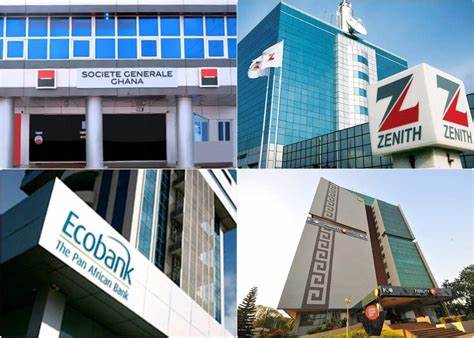Banks in the country registered ¢2.9 billion in the first four months of 2022, signaling a healthy industry, the Bank of Ghana has revealed.
This represented a 26.3 % growth, compared with 39.6% growth for the same period of last year.
The banks’ earnings were influenced by growth in net interest income and net fees and commissions. However, the growth margins went down, comparatively to last year.
Net interest income grew by 12.2% to ¢4.6 billion, compared to 18.4% growth a year ago. Net fees and commissions grew by 17.7% to ¢1.1 billion, compared with 26.5% growth last year, due to decline in trade finance-related activities in the economy.
Other income increased to ¢1.0 billion, representing 117.5% growth, relative to the contraction by 7.9% last year.
Banking sector assets remain strong
Also, developments in the banking sector also indicated strong performance, despite the reversal of the COVID-19 regulatory relief measures in March.
Total assets rose to ¢194.3 billion at the end of April 2022, about 24.8% annual growth, relative to 16.4% growth in the previous year.
The growth was underscored by increased deposits and borrowings.
Total deposits grew by 21.3% to ¢127.2 billion, while borrowings recorded a strong growth of 66.2% to ¢25.9 billion at the end of April 2022.
Financial Soundness Indicators robust
According to the Bank of Ghana, the key Financial Soundness Indicators also remained strong, with the Capital Adequacy Ratio at 21.3%, well above the regulatory minimum of 13.0%.
Importantly, Non-Performing Loan ratio eased to 14.3%, compared with 15.5% the previous year.
These developments resulted in a 22.1% jump in operating income to ¢6.7 billion, compared with 16.8% growth in the corresponding period of 2021.
Operating expenses recorded 23.0% growth compared to 1.7 % growth in the previous year.
Credit to private sector shows considerable improvement
The Bank of Ghana said credit to the private sector showed considerable improvement, almost back to pre-pandemic levels and broadly in line with the uptrend in economic activities.
In nominal terms, private sector credit recorded a significant annual growth of 26.5% in April 2022, compared with 6.9% in April 2021.
In real terms, however, private sector credit grew by 2.3%, due to sustained price pressures, relative to a contraction of 1.5% recorded for the same comparative period.
In terms of new advances, the data shows that credit growth continued to improve, reaching ¢16.4 billion, representing a 56.5 percent year-on-year growth.
Meanwhile, the latest credit conditions survey revealed that banks are however beginning to tighten credit stance on loans to enterprises and households. Despite the tightening of credit conditions, demand for credit by households and firms continue to remain strong.
Latest Stories
-
Disregard Wontumi TV presenter’s misleading broadcast on Election 2024 voting date – EC
1 hour -
I’ve no plans to leave comedy for movie production, says Basketmouth
2 hours -
Akufo-Addo seeks to use Bawumia to complete Akyem Agenda– Asiedu Nketiah
2 hours -
‘Bawku conflict politicised for electoral gains’ -Martin Amidu alleges
2 hours -
‘Let industry players play the game ‘ – AOMC boss slams political interference in oil sector
3 hours -
Let’s learn from ExxonMobil, high flyers must lead the way for mergers – AOMC Boss
3 hours -
‘So many regulations, yet corruption prevails’ – Dr Riverson Oppong on OMC oversaturation
4 hours -
At least 24 dead after two boats capsize off coast of Madagascar
4 hours -
Madina MP lauds White Chapel Youth Group for championing peace ahead of elections
5 hours -
Man United settle for draw at Ipswich Town in Amorim’s first game in charge
5 hours -
GPL 2024/2025: Prince Owusu screamer earns Medeama win over Young Apsotles
5 hours -
BBC visits mpox clinic as WHO says DR Congo cases ‘plateauing’
5 hours -
Burning old TVs to survive in Ghana: The toxic trade in e-waste
6 hours -
Perfume boss admitted he ignored Russia sanctions
6 hours -
Wicked proves popular as opening set to be biggest for Broadway film
6 hours

